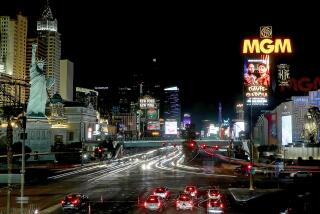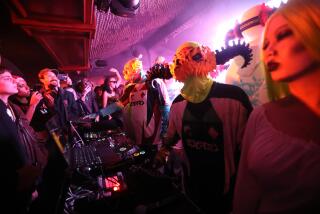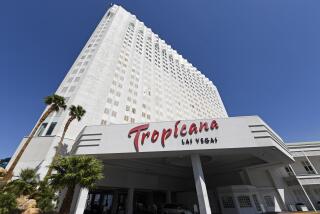Bugsy Siegel’s Las Vegas
To Millicent Siegel Rosen, her father was a loving parent. She knew nothing of his life as one of America’s most notorious gangsters — and to this day, does her best to steer the conversation away from her father’s infamy.
“I adored my father,” she said of Benjamin Siegel, better known as Bugsy. “I was raised like a princess,” she said as she previewed the Mob Experience, Las Vegas’ newest attraction, set to open Feb. 17, and one of three devoted to the nefarious characters who once ran Sin City.
Rosen, 79, was a consultant on the project, the latest in a series of snazzy updates to the aging Tropicana resort. Complete with holograms and other sensory surprises, the Mob Experience tells the story of the thugs who built and then controlled the Strip. Visitors will be escorted through the various exhibits and can interface with live actors as they decide whether to take a bribe and, later, whether to let a thug live or get whacked.
Using special effects created by former Disney Imagineers, interlopers will see three-dimensional images of Siegel and fellow mobster Meyer Lansky, standing next to Bugsy’s real car, as they discuss building the Flamingo, the first upscale hotel-casino along Las Vegas Boulevard.
Suddenly, the ground shakes. The scent of dust and sage fills the heat-seared air. Rocks fly as an 18-foot-high hologram of the resort rises from the desert floor.
Planning your trip
The Mob Experience opens Feb. 17 at the Tropicana, 3801 Las Vegas Blvd. South; (702) 589-9450, https://www.lvme.com. Tickets are $29.95 for adults and $21.95 for children ages 4 to 12.
The Vegas Mob Tour, (866) 218-4935, https://www.vegasmobtour.com, operates six nights a week. Pickup is at the Royal Resort, 99 Convention Center Drive. Tickets costs $66.25. Guests must be at least 16 years old.
That’s Jay Bloom’s favorite moment. “It’s kind of the ‘Eureka!’ moment for the mob in Las Vegas and for the city itself,” said Bloom, the attraction’s founder.
Siegel’s daughter said her father energized the city. “He pushed Vegas to become what it is today,” she said.
A marker dedicated to the Flamingo’s infamous founder stands discreetly in the gardens behind the high-rise hotel, which replaced the original buildings years ago. It’s one of several notable stops on the already-established Vegas Mob Tour.
Guests learn that the gardens are on the site of the first hotel building, in which Bugsy kept an apartment. It was constructed with multiple escape routes, including a ladder hidden within a hall closet. It led to an underground tunnel and a getaway car, in which a chauffeur waited around-the-clock in case Siegel had to make a hasty exit.
Guests are occasionally joined by Frank Cullotta, a former mob hit man who entered the government’s witness protection program about 20 years ago after testifying against his underworld colleagues. He now helps keep the spiel authentic.
“Every once in a while, I … jump on the bus to see how these guys are handling it,” he said with a chuckle.
Cullotta is also helping with inside information for southern Nevada’s third mob-related visitor attraction, the Las Vegas Museum of Organized Crime and Law Enforcement, slated to open in the fall.
The Mob Museum, as it’s more succinctly known, is a pet project of Las Vegas Mayor Oscar Goodman, a lawyer who once represented gangland figures. The former federal courthouse in downtown Las Vegas — where U.S. Senate committee hearings into organized crime were held in November 1950 — will house the attraction.
“People will be anxiously coming to Las Vegas with the intent of seeing this museum,” Goodman said in the courtroom during a ceremony marking the 60th anniversary of the hearings.
The mayor, however, bristled when asked whether Las Vegas was big enough for two attractions devoted to the mob.
“This is a museum,” he replied. “The other is a quick fix.”
The Mob Experience’s Jay Bloom disagreed. “The stories are so fantastic and so dynamic that a static museum doesn’t do them justice,” he said.
“We’re neither glorifying nor vilifying the mob,” Bloom added. “Some of them really were vicious killers … but at the same time, they were incredibly generous. They had their own moral compass. That dichotomy in personality is the greatest story never told.”
More to Read
Sign up for The Wild
We’ll help you find the best places to hike, bike and run, as well as the perfect silent spots for meditation and yoga.
You may occasionally receive promotional content from the Los Angeles Times.






